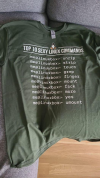Deety
Head Coach
So... my backup system hasn't actually backed up one of my drives for a few months (despite all that "checking for changes" nonsense), and now the drive has failed, which is just a bit of a horrendous disaster. It threw it into chkdsk a couple of times and and stalled after completing Journal Verification. Once, I cancelled chkdsk (I know, not bright) and it showed the drive, but then I had to shutdown to add a drive big enough to handle the data, and it didn't go to chkdsk or show again. I've tried to grab an image and tried using it in a dock (spins up but won't stay connected long enough to run anything), and am freaked out at the thought of messing further with a dying disk.
The goal is now to get as much as I can possibly salvage from my old drive H: (2TB WD Green) to my new drive I: (4TB WD Black). A full recovery would be ideal, but even if I can get in to grab recent files and some files that were too big for my online backup, that would suffice.
It seems as though the next step is to try accessing it with Linux (which I have not used before), but I've been looking at this guide (Method 3) and am extremely confused. Can anyone help me out, or suggest a better plan?
If I'm booting to a Linux flash drive, which distro do I use? Is the SystemRescue Live CD just a version of bootable Linux with that program built in? If not, how do I install programs when I'm booting off a flash drive?
If I boot to Linux and then image the drive (since I can't image it in Windows), should I be using DD (which I would also have to learn) to make the image? Would I have to NOT use the SystemRescue Live CD because I don't want to scan it at this point?
I can't figure out steps 7, 8, and 9 at all. Why am I mounting drives in all three steps, rather than just telling it to copy H: to my new drive I:?
Is there an easier way to summarize what should be done than in that guide?
Thanks so, so much to anyone who can help.
The goal is now to get as much as I can possibly salvage from my old drive H: (2TB WD Green) to my new drive I: (4TB WD Black). A full recovery would be ideal, but even if I can get in to grab recent files and some files that were too big for my online backup, that would suffice.
It seems as though the next step is to try accessing it with Linux (which I have not used before), but I've been looking at this guide (Method 3) and am extremely confused. Can anyone help me out, or suggest a better plan?
If I'm booting to a Linux flash drive, which distro do I use? Is the SystemRescue Live CD just a version of bootable Linux with that program built in? If not, how do I install programs when I'm booting off a flash drive?
If I boot to Linux and then image the drive (since I can't image it in Windows), should I be using DD (which I would also have to learn) to make the image? Would I have to NOT use the SystemRescue Live CD because I don't want to scan it at this point?
I can't figure out steps 7, 8, and 9 at all. Why am I mounting drives in all three steps, rather than just telling it to copy H: to my new drive I:?
Is there an easier way to summarize what should be done than in that guide?
Thanks so, so much to anyone who can help.
Last edited:



